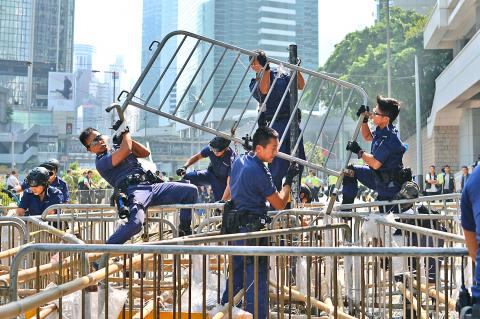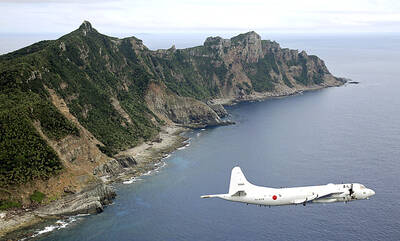Hong Kong police yesterday vowed to tear down more street barricades manned by pro-democracy protesters, hours after hundreds of officers armed with chainsaws and boltcutters partially cleared two major roads occupied for two weeks.
In a concerted effort to reduce the territory held by protesters, police tore down barricades in the bustling shopping district of Causeway Bay and on the edge of the main protest encampment in Admiralty, near the city government’s headquarters. They also vowed to target protester cordons in Mongkok, a working-class district known for its triad gangs, where violence has previously broken out.
Huge crowds have intermittently rallied against China’s insistence that it will vet candidates standing for election as the semi-autonomous city’s next leader in 2017 — a move protesters have labeled “fake democracy.”

Photo: AFP
While the activists have been praised for their civility and organizational skills, they have also brought widespread disruption to an already densely populated city. Angry and sometimes violent scuffles have broken out between demonstrators and government loyalists, sparking accusations the authorities are using hired thugs to sow trouble.
Police had been keeping a low profile at the three main protest sites after a decision to fire tear gas at peaceful demonstrators on Sept. 28 caused outrage and encouraged tens of thousands to take to the streets.
However, in the past two days, officers have begun probing protester defences in raids aimed at opening some roads to traffic, while allowing the bulk of demonstrators to stay in place. About 150 police dismantled metal barricades at the Causeway Bay site before dawn yesterday, freeing up traffic in one direction, but leaving the protest camp there largely intact.
Hours later, another contingent of officers tackled barricades at the main Admiralty site, using chainsaws to slice through bamboo poles and freeing up one of the multi-lane highways in the district.
At both sites protesters put up little resistance, sticking to their promise of non-violence.
Some protesters were seen sobbing as police went to work dismantling the barricades.
“We are only residents and students,” one tearful young woman shouted at police. “We will leave, as we are unable to fight you, but we will not give up.”
Police insisted they would soon turn their attention to Mongkok.
A similar clearance operation on Monday at the edges of the Admiralty protest camp prompted activists there to swiftly regroup.
They laid down cement foundations and built up bamboo pole barricades blocking both lanes of a highway, using everything from steel chains to plastic cable ties and sticky tape to strengthen them — even enlisting sympathetic construction workers for help.
However, police yesterday cleared them in less than an hour.

MISINFORMATION: The generated content tends to adopt China’s official stance, such as ‘Taiwan is currently governed by the Chinese central government,’ the NSB said Five China-developed artificial intelligence (AI) language models exhibit cybersecurity risks and content biases, an inspection conducted by the National Security Bureau (NSB) showed. The five AI tools are: DeepSeek, Doubao (豆包), Yiyan (文心一言), Tongyi (通義千問) and Yuanbao (騰訊元寶), the bureau said, advising people to remain vigilant to protect personal data privacy and corporate business secrets. The NSB said it, in accordance with the National Intelligence Services Act (國家情報工作法), has reviewed international cybersecurity reports and intelligence, and coordinated with the Ministry of Justice Investigation Bureau and the National Police Agency’s Criminal Investigation Bureau to conduct an inspection of China-made AI language

LIMITS: While China increases military pressure on Taiwan and expands its use of cognitive warfare, it is unwilling to target tech supply chains, the report said US and Taiwan military officials have warned that the Chinese People’s Liberation Army (PLA) could implement a blockade within “a matter of hours” and need only “minimal conversion time” prior to an attack on Taiwan, a report released on Tuesday by the US Senate’s China Economic and Security Review Commission said. “While there is no indication that China is planning an imminent attack, the United States and its allies and partners can no longer assume that a Taiwan contingency is a distant possibility for which they would have ample time to prepare,” it said. The commission made the comments in its annual

‘TROUBLEMAKER’: Most countries believe that it is China — rather than Taiwan — that is undermining regional peace and stability with its coercive tactics, the president said China should restrain itself and refrain from being a troublemaker that sabotages peace and stability in the Indo-Pacific region, President William Lai (賴清德) said yesterday. Lai made the remarks after China Coast Guard vessels sailed into disputed waters off the Senkaku Islands — known as the Diaoyutai Islands (釣魚台) in Taiwan — following a remark Japanese Prime Minister Sanae Takaichi made regarding Taiwan. Takaichi during a parliamentary session on Nov. 7 said that a “Taiwan contingency” involving a Chinese naval blockade could qualify as a “survival-threatening situation” for Japan, and trigger Tokyo’s deployment of its military for defense. Asked about the escalating tensions

DISPUTE: A Chinese official prompted a formal protest from Tokyo by saying that ‘the dirty head that sticks itself out must be cut off,’ after Takaichi’s Taiwan remarks Four armed China Coast Guard vessels yesterday morning sailed through disputed waters controlled by Japan, amid a diplomatic spat following Japanese Prime Minister Sanae Takaichi’s comments on Taiwan. The four ships sailed around the Senkaku Islands — known as the Diaoyutai Islands (釣魚台) to Taiwan, and which Taiwan and China also claim — on Saturday before entering Japanese waters yesterday and left, the Japan Coast Guard said. The China Coast Guard said in a statement that it carried out a “rights enforcement patrol” through the waters and that it was a lawful operation. As of the end of last month,